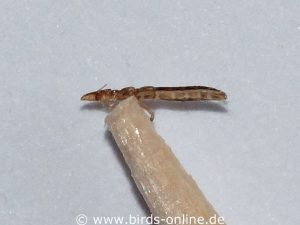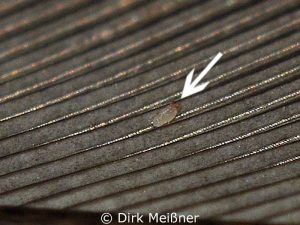- >>
- Birds Online – English
- >>
- Health and diseases
- >>
- Parasitic infestations
- >>
- Bird lice (mallophaga)
Bird lice (mallophaga)
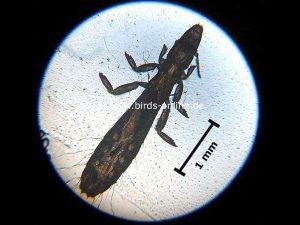
Feather lice belong to the group of ectoparasites. This is how parasites that live on the surface of the birds’ bodies are called. Within the class of insects, these tiny animals belong to the order Phthiraptera and they inhabit the plumage of their hosts. There they feed on the feathers and can cause visible damage to the plumage if they occur in large numbers. Several species of bird lice can be found in budgies and other pet birds, each affecting preferred bird species. And although there are several different species of bird lice, their habits are pretty similar, which is why they are described in this chapter together rather than at the specific species level. The photo near this paragraph shows a bird louse that has been living on a Wood Pigeon. It was taken using a microscope at 4x magnification.
Appearance of bird lice
Due to their body size, which is up to 3 mm, fully grown bird lice can be spotted with the naked eye, in case you get the chance to see them. Most species are dark, for example, gray or gray-brown. As is typical for insects, they have six legs and their bodies are elongated and slender. Bird lice are very shy of light and when exposed to it, they scurry under the feathers. For example, if you carefully spread an affected bird’s wing feathers, the lice will try to find shelter immediately. Larvae of feather lice are smaller than adult individuals. Very young larvae measure less than 1 mm. Therefore, they can usually only be detected by using a magnifying glass.
Since these lice permanently live in the plumage, they also reproduce there. They stick their eggs, the so-called nits, in rows on the feather shafts or branches. Depending on the species of bird lice, the eggs develop into larvae in one to two weeks, so they hatch quite quickly. After hatching, the larvae turn into adult lice within about five weeks.
Transmission of these parasites
Because bird lice cannot fly, they must be able to reach new hosts on foot. They can do this especially when an affected bird is in physical contact with another bird. Then the bird lice can easily climb from one animal to another and settle on the latter. If only male lice get onto a bird, they cannot reproduce and die after a while. Admittedly, they can cause feeding damage to the feathers during the time they spend in the plumage. But the infestation disappears by itself after some time. However, this is unlikely because in most cases, males and females get onto new hosts and reproduce there. Theoretically, by the way, it takes only one fertilized female to get onto a new host animal, lay eggs, and thus found a new population.
In severe infestations, it can also happen that affected birds frequently manipulate their plumage with their beaks and shake their feathers vigorously. As a result, bird lice can be flung through the air and land on birds in neighboring cages or aviaries. If the bird lice fall on the ground or branches instead, they will approach the birds in the vicinity and climb into their plumage. Thus, direct physical contact of an affected and another healthy bird is not required in each case to transmit bird lice. It may be sufficient that there are other birds around, for example being kept in the same room.
Symptoms of infestation and detecting bird lice
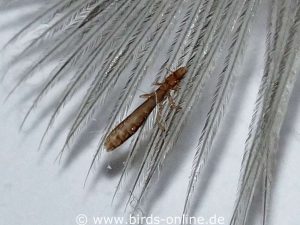
In a moderate to severe infestation of bird lice, the feathers look plucked and gnawed because many lice have fed on them. The feathers are often chewed at the tips or even show holes in the middle. Many of the affected birds suffer from itching and thus usually from lack of sleep. If one observes these symptoms, it is advisable to grip the bird carefully and to stroke the plumage against the grain. In many cases, you can see lice then. Or you should fan out the wing feathers to look for bird lice. When doing so, you have to look quickly and closely. Because of their shyness to light, adult bird lice are difficult to detect since they hide very quickly.
It’s considerably easier to detect the nits (eggs) on the birds’ feathers. On the underside of the individual feathers especially on the wings, the eggs are evident as brownish discolorations. The larvae are also shy of light, but they can only flee much more slowly than the adult lice. Nevertheless, larvae are difficult to spot on the feathers because they’re so small.
Treatment
If an infestation with bird fluke is suspected, an avian vet should be contacted to discuss how to proceed. Usually, specific insecticides are used to help the affected bird get rid of the lice. Often, powders containing the active ingredient pyrethrum are applied. However, these powders are not entirely harmless to the birds, which is why the utmost caution is required in application and dosage. The feathered patients are powdered with insecticides mainly on the undersides of the wing feathers. This is where bird lice are found in the majority of cases.
In stores, several products are offered that are supposedly safe and can be used without hesitation. Unfortunately, some birds are extremely sensitive and deaths can occur after the application of such poisons. Therefore, I strongly advise you to contact an experienced vet in any case and discuss the further procedure in the individual situation.
Most frequently affected bird species
Bird lice occur rather rarely in budgies and most other parrot species. They mainly infect doves and pigeons and wild birds, but can also appear in pet birds who are kept in outdoor aviaries and thus potentially are in contact with wild birds. Pet birds who have escaped and been captured outside are also part of the risk group because they may have come in touch with affected wild birds. Since transmission generally takes place through physical contact, there is only a small risk for birds kept indoors and not getting in touch with other birds.
Similar symptoms
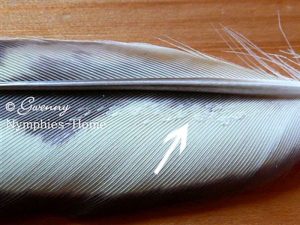
Sometimes, deposits that look like parasites or their eggs can form on feathers can appear. For example, if a bird suffers from extreme stress or nutrient deficiency, keratin deposits may develop while the feathers are growing. These white deposits resemble nits or elongated parasites in appearance. By using a magnifying glass, you can check if you are facing bird lice eggs, parasites, or just keratin deposits. If you are not sure, you should take a suspicious feather or the bird to an avian vet for an examination.

